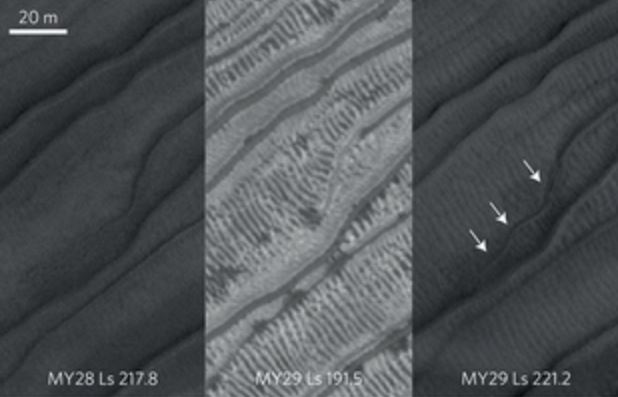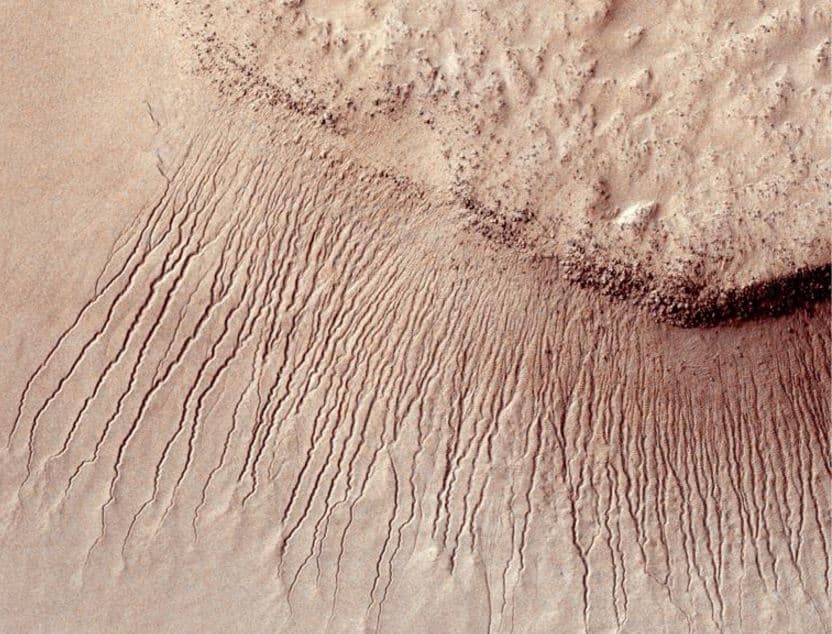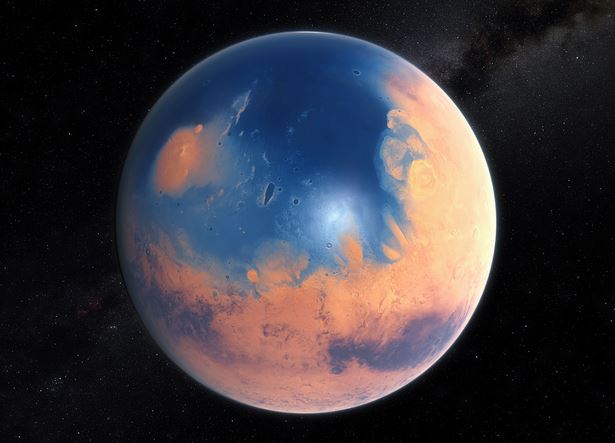The gullies observed on Mars that got everybody excited because they thought they were caused by rivers of water, were more likely the result of trapped CO2 gas, which builds up pressure and causes sand to flow downhill and leave small ravine-like landforms in its wake, two French scientists reported in the academic journal Nature Geoscience.
A gully is a landform, like a ravine, created by running water which erodes sharply into the soil, typically on a hillside. Gullies look like large ditches or small valleys.
When the gullies were first discovered on Mars, there was great excitement because people imagined a planet in the distant past with flowing rivers, just like Earth.
 This image shows gullies on the Russell crater megadune. (Image: www.nature.com)
This image shows gullies on the Russell crater megadune. (Image: www.nature.com)
Scientists Francois Forget from Sorbonne Universités, and Cedric Pilorget from the Université Paris-Sud, explained that during the Martian winters, a layer of dry ice or carbon dioxide (CO2) frost forms on the surface of several parts of the Red Planet.
Pressure from trapped CO2 is the likely cause
When this dry ice defrosts, CO2 gas is trapped under the surface. This gas creates a pressure build-up.
The authors suggest that this trapped carbon dioxide is probably the cause of the gullies on the surface of Mars.
Several regions on Mars’ surface near its equator have small valleys that have been cut into dunes and hillsides.
A number of scientists believe these dunes and hillsides were formed during a period in Mars’ ancient past when it had water.
Many of the formations, however, are relatively young, geologically speaking. In fact, they are still being formed.
As the surface of Mars in these regions is extremely cold, where water cannot exist in a liquid form, Pilorget and Forget wondered whether something else may have been responsible for the gullies that formed on the sand dunes.
 This NASA image shows many channels from 1 meter to 10 meters wide on a scarp in the Hellas impact basin. On Earth we would call these formations gullies. Some larger channels on Mars that are sometimes called gullies are big enough to be called ravines on Earth. (Image: jpl.nasa.gov)
This NASA image shows many channels from 1 meter to 10 meters wide on a scarp in the Hellas impact basin. On Earth we would call these formations gullies. Some larger channels on Mars that are sometimes called gullies are big enough to be called ravines on Earth. (Image: jpl.nasa.gov)
Does not mean there was no water in Mars
Over the past few years scientists have gathered a mountain of data about Mars from rovers on the Red Planet and NASA satellites. According to much of the data, Mars did once appear to have lots of water.
The Curiosity rover, a car-sized robotic rover exploring Gale Crater on Mars as part of NASA’s Mars Science Laboratory mission, found signs of several lakes which rose and fell in the crater over a period of many millions of years.
A number of studies have even suggested that huge oceans once existed on Mars, which over time gradually vanished. One study proposed that a huge ocean once covered 19% of the planet.
Apart from mounting proof of likely abundant water a very long time ago in Mars, there is some evidence of a small amount liquid water on Mars’ surface today.
 An artist’s impression of what Mars may have looked like about 4 billion years ago, with vast oceans. (Image: www.eso.org)
An artist’s impression of what Mars may have looked like about 4 billion years ago, with vast oceans. (Image: www.eso.org)
Scientists carried out modeling simulation
In this latest study, Forget and Pilogret suggest that the dry ice that forms on the surface changes from a solid directly to a gaseous state (sublimation) when winter ends. Because of this process, small quantities of CO2 get trapped below the surface.
They carried out a modeling simulation on how this process could happen on a huge dune in the Russel Crater on Mars. As the trapped CO2 gas causes pressure to build up, a ‘gas-lubricated debris flow’ occurs, i.e. sand flows downhill creating a gully along the way.
In an Abstract in the journal, the authors concluded:
“Moreover, we find that subsurface CO2 ice condensation, sublimation and pressurization occurs at conditions found at latitudes and slope orientations where gullies are observed.”
“We conclude that Martian gullies can result from geologic dry ice processes that have no terrestrial analogues and do not require liquid water. Such dry ice processes may have helped shape the evolution of landforms elsewhere on the Martian surface.”
Research geologist Colin Dundas, who works at the Astrogeology Science Center, U.S. Geological Survey, Arizona, wrote in the News & Views section of Nature Geoscience:
“Martian gullies have been seen as evidence for past surface water runoff. However, numerical modelling now suggests that accumulation and sublimation of carbon dioxide ice, rather than overland flow of liquid water, may be driving modern gully formation.”
Citation: “Formation of gullies on Mars by debris flows triggered by CO2 sublimation,” C. Pilorget & F. Forget. Nature Geoscience. 21 December 2015. DOI: doi:10.1038/ngeo2619.
Video – NASA images of gullies on Mars
In early April, NASA’s Mars Reconnaissance Orbiter took this photo with its High Resolution Imaging Science Experiment camera that shows frost build up in several gullies. Some seasons on Mars bring frost-covered peaks and valleys similar to what we find on Earth.

